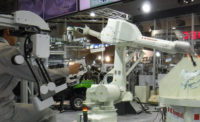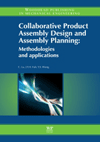TOKYO—Kawasaki Heavy Industries Ltd. recently unveiled a new robotic system that enables remote collaboration by reproducing the movements of engineers. The Successor is currently being used at Kawasaki’s Nishi-Kobe Works in Japan, which produces hydraulic components, such as motors, pumps and valves. It will be commercially available to other manufacturers later this year.
The Successor system features newly developed controls and sensors that enable remote collaboration. It is compatible with a wide range of Kawasaki robots.
“The system can take movements operated by engineers by means of remote devices and convert them into automated operations by a robot,” says Yasuhiko Hashimoto, general manager of Kawasaki’s robot division. “By learning repeatedly operated moves using artificial intelligence technology, [the robot] will reproduce delicate movements that require fine adjustment.
“The Successor allows for streamlining workflow in fields that were previously difficult to automate through the use of robots,” claims Hashimoto. “It also [enables] the master craftsmen who have supported Japan’s culture of manufacturing [to pass on precious skills] to later generations.”
According to Hashimoto, the name “successor” has three meanings. “A robot inherits skills; those skills are conveyed to young technicians through the robot; and, finally, it broadens the scope of robot application, spreading new concepts to the world,” he explains.
“The Successor enables a worker to operate the robotic arm remotely using a dedicated operation device similar to a controller,” adds Hashimoto. “The shape of the device differs depending on the applications. Just by performing actual factory work using the controller, the robot learns of the subtle nuances in the human’s movements during the task and reproduces those movements.
“The sensory feedback capability lets users feel the weight and vibrations of the work being done through the robot arm as if the work was actually being done by hand,” Hashimoto points out. “This remote-control device can also, through the camera and microphone, which serve as eyes and ears, comprehensively capture information, record the state of having correctly completed work and reproduce the entire process.
“Even today, robots are not suited to do a number of tasks,” says Hashimoto. “Take, for example, the process of [installing] a car seat. Since there are subtle variations to the mounting position depending on the vehicle, humans determine the correct position using the feeling from their palms, and only then the car seat can be [attached].
“Although it may be easy for human beings, it is a different story for robots that specialize in accurately repeating the same preset tasks,” explains Hashimoto. “Robots are usually unable to deal with tasks that require judgment at various situations every time.
“As humans repeat tasks, the Successor accumulates data such as positioning, speed and acceleration,” says Hashimoto. “By analyzing this data, the robot is able to learn the tricks of the trade.”









